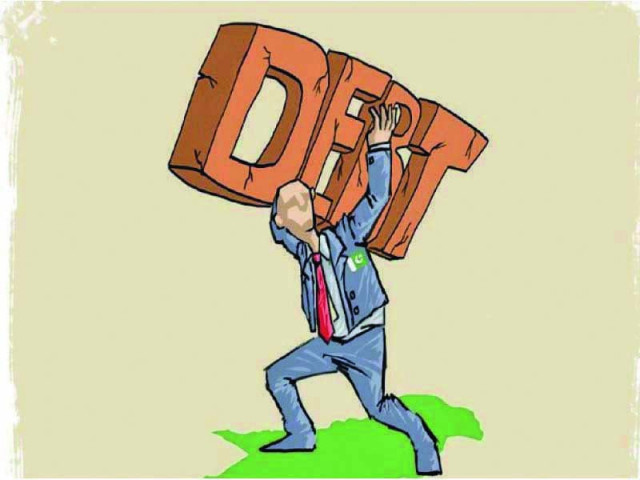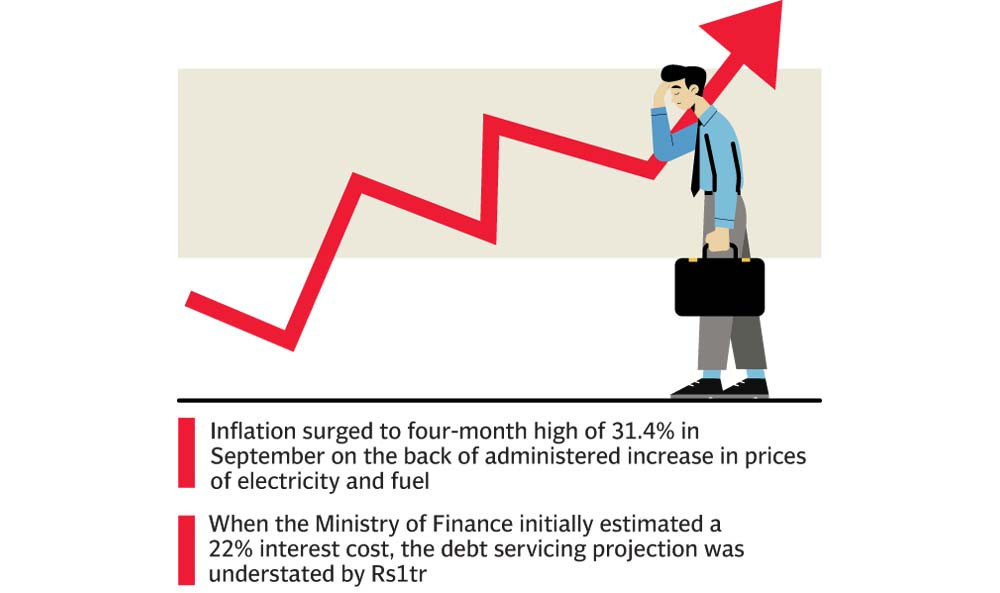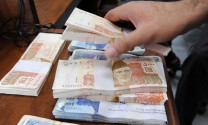1% rate hike adds Rs600b to debt cost
If ministry's claim is accurate, budget for FY2024 is understated by Rs2.4tr

A senior official from the finance ministry claimed, on Wednesday, that a 1% increase in the interest rate adds a whopping Rs600 billion in annual debt servicing costs. If accurate, this figure could have a significant impact on this fiscal year’s budget.
This revelation was made during a session of the Senate Standing Committee on Finance, which also requested a report from the central bank regarding the relationship between interest rate increases and a slowdown in the inflation rate.
Chaired by Senator Saleem Mandviwalla of the Pakistan Peoples’ Party, the standing committee criticised the central bank’s policy of curbing inflation by raising the monetary policy rate as “ineffective,” citing heavy losses incurred by businesses.
The government’s debt servicing cost increases by Rs600 billion with a 100 basis point increase in the monetary policy rate, said Amjad Mehmood, the additional secretary of the Ministry of Finance.
While these figures appear on the higher end, earlier estimates suggested that a 1% increase in interest costs added a minimum of Rs250 billion to Rs260 billion to the government’s debt servicing expenses.
If Mehmood’s claim of a Rs600 billion impact per 1% rate increase is accurate, the federal budget for the current fiscal year is understated by at least Rs2.4 trillion.
Parliament had approved a debt servicing cost of Rs7.3 trillion for the current fiscal year. However, a recent assessment by the finance ministry revealed that interest payments could exceed Rs8 trillion.
This higher cost is attributed to the government’s initial estimate of interest payments based on an 18% interest rate assumption. When the Ministry of Finance initially estimated a 22% interest cost, the debt servicing projection for this fiscal year was understated by Rs1 trillion.
Senator Faisal Sabzwari of the Muttahida Qaumi Movement noted that inflation has not slowed down despite raising the interest rate to a record high of 22%.
In September, inflation reached a four-month high of 31.4%, driven by administered price increases for electricity and fuel.
SBP Deputy Governor, Dr Inayat Husain, explained that interest rates were increased to curb aggregate demand in the economy. He anticipates that the inflation rate will start to decrease again this month.
Inconsistent Economic Policies
According to the World Bank’s Pakistan Development Update report, “policy inconsistency has constrained the effectiveness of monetary policy in curbing inflation.” The report, released on Tuesday, highlighted inconsistencies in the current policy framework. Attempts to curb inflation through policy rate increases have been partly undermined by simultaneous expansion in the monetary base.
The report also noted that higher policy rates are increasing government borrowing costs, leading to higher financing needs. These financing needs are being met through increased borrowing from the domestic banking system, necessitating greater liquidity injections from the central bank.
The World Bank warned that any sudden halt in lending to commercial banks for government lending could leave banks unable to extend further loans to the government.
The report suggested that the only sustainable solution is to reduce the government’s primary deficit, thereby reducing financing needs and borrowing from the domestic banking sector, alleviating the need for new liquidity injections.

design: Ibrahim Yahya
However, the same World Bank report indicated that Pakistan may miss the International Monetary Fund’s primary budget surplus target, with the overall budget deficit potentially reaching Rs8.2 trillion against the annual target of Rs6.9 trillion.
Senator Sabzwari suggested that Pakistan should engage with the IMF to discuss the policy of curbing inflation through interest rate increases, as this policy has not helped achieve its objectives.
Since July 2022, the SBP has raised the policy rate by 8.25% to 22%, yet inflation reached a record high of 38% in May this year.
The World Bank highlighted that the real interest rate remains negative, with inflation averaging 29.2% in the last fiscal year. Tight monetary policy is expected to continue in the near term due to persistent inflationary pressures and slight increases in inflation expectations.
As of June this year, banks had allocated 74% of their total loans to the public sector, reflecting the government’s substantial borrowing needs. In contrast, credit to the private sector remained low, standing at 26.2%, down from 30.3% of total bank credit in June 2022. This decline is attributed to the government’s increasing reliance on financing from commercial banks amid limited external financing inflows.
The World Bank also expressed concerns about growing risks to banks from bad debts. While bank profitability has increased with rising interest rates, underlying risks have also risen. The sovereign-bank connection, ongoing macroeconomic instability, and deteriorating asset quality have negatively impacted banks’ capital positions.
Although the aggregate commercial banks’ capital adequacy ratio stood at 16.3% in March 2023, down from 17% in December 2022, some smaller banks remain undercapitalised. Additionally, the capital adequacy ratio does not adequately account for the risks of banks’ exposure to the government.
The economic slowdown has further impacted banks’ asset quality, with the ratio of non-performing loans (NPLs) to total lending increasing marginally to 7.8% in March 2023 from 7.5% in June 2022. While 90.7% of NPLs are provisioned for, risks are emerging, with many banks experiencing a rapid increase in NPLs.
Published in The Express Tribune, October 5th, 2023.
Like Business on Facebook, follow @TribuneBiz on Twitter to stay informed and join in the conversation.



















COMMENTS
Comments are moderated and generally will be posted if they are on-topic and not abusive.
For more information, please see our Comments FAQ